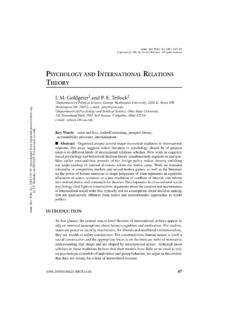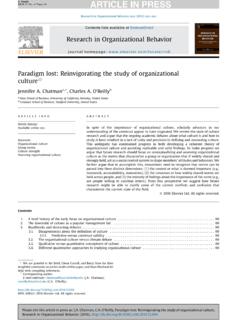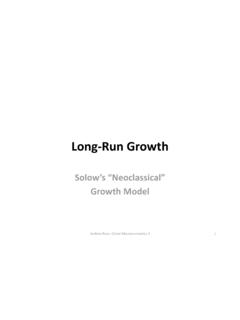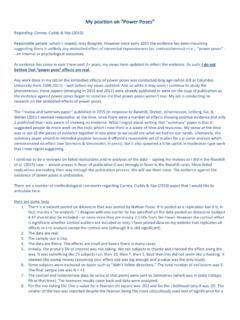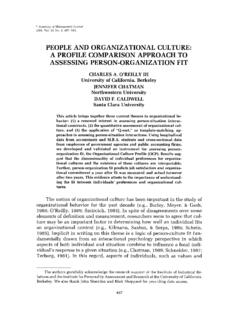Transcription of How leadership matters: The effects of leaders' alignment ...
1 how leadership matters : The effects of leaders ' alignment onstrategy implementationCharles A. O'Reillya, , David F. Caldwellb, Jennifer A. Chatmanc, Margaret Lapizd, William SelfcaGraduate school of Business, Stanford University, United StatesbLeavey school of Business, Santa Clara University, United StatescHaas school of Business, University of California, United StatesdThe Permanente Medical Group, United Statesarticle infoabstractResearch has confirmed that leader behavior influences group and organizational behavior, butwe know less abouthowsenior leaders ensure that group and organizational membersimplement their decisions. Most organizations have multiple layers of leaders , implying thatany single leader does not lead in isolation. We focused on how the consistency of leadershipeffectiveness across hierarchical levels influenced the implementation of a strategic initiative ina large health care system.
2 We found that it was only when leaders ' effectiveness at differentlevels was considered in the aggregate that significant performance improvement discuss the implications of thesefindings for leadership research, specifically, that leadersat various levels should be considered collectively to understand how leadership influencesemployee performance. 2009 Elsevier Inc. All rights :LeadershipStrategy implementationOrganizational performance1. IntroductionLeadership has been a central, but sometimes controversial, topic in organizational research ( ,Chemers, 2000; Hogan,Curphy, & Hogan, 1994; House & Aditya, 1997; Judge & Piccolo, 2004; Khurana, 2002; Meindl, 1990). For example, reflecting amacro-OB perspective, Podolny, Khurana and Hill-Popper observed that for at least the past thirty years, the concept ofleadership has been subject to criticism and marginalization by the dominant organizational paradigms and perspectives (2005:1).
3 Part of this skepticism has resulted from questions about the definition of the construct as well as whether leadershiphas discernable effects on organizational outcomes (Hannan & Young, 1984; Pfeffer, 1977). Proponents of leadership argue thatleaders, by their very roles, are responsible for making decisions that help their organizations adapt and succeed in competitiveenvironments ( ,Bass, 1991; Waldman & Yammarino, 1999). In contrast, those who view organizations as heavilyconstrained claim that leadership is largely irrelevant and, at best, a social construction ( ,Hannan & Freeman, 1989; Meindl,1990).While provocative, the assertion that leaders in organizations do not play a distinct role in influencing groups and individuals toachieve organizational goals, is not supported by the empirical evidence; leaders often have a substantial impact on performance( ,Barrick, Day, Lord, & Alexander, 1991; Bass, Avolio, Jung, & Berson, 2003; Bertrand & Schoar, 2003; Judge & Piccolo, 2004;Judge, Piccolo, & Ilies, 2004; Koene, Vogelaar, & Soeters, 2002).
4 The circumstances under which leaders are able to affectperformance are less clear, however ( ,Hambrick, Finkelstein, & Mooney, 2005).The leadership Quarterly 21 (2010) 104 113 Corresponding O'Reilly).1048-9843/$ see front matter 2009 Elsevier Inc. All rights lists available atScienceDirectThe leadership Quarterlyjournal homepage: situation in which leadership effectiveness may be most visible is when an organization changes its strategy . Adoptinga new strategic initiative is distinct from implementing it (Pfeffer & Sutton, 2000), but research investigating leaders ' roles insuch change often blurs the two processes. For example, studies of CEO succession that examined subsequent changes inorganizational performance associated with the appointment of a new CEO have implicitly assumed that the new CEO was ableto implement change throughout the entire organization and that leaders at lower hierarchical levels were supportive of thechange ( ,House & Aditya, 1997; Lieberson & O'Connor, 1972; Thomas, 1988; Wasserman, Anand, & Nohria, 2001; Weiner &Mahoney, 1981).
5 A more nuanced perspective, however, would acknowledge that for a senior leader to affect organizationalperformance requires that managers and employees at lower levels also support the new strategy ( ,Guth & Macmillan,1986; Lee & Miller, 1999).To implement a new strategic initiative, leaders at subordinate levels must reinforce it; that is, they must allocate resources forit, deal effectively with resistance to it, and convince employees that the new initiative is important and in the employees' intereststo support (Cannella & Monroe, 1997; Rotemberg & Saloner, 1993). A number of studies have illustrated how a crucial determinantof successfully implementing a new strategic initiative is whether lower level leaders support the change ( ,Burgelman, 1983).
6 For example, in a study of 196 managers across 20 organizations,Wooldridge and Floyd (1990)found that the more involvedmiddle level leaders were in formulating their organization's strategy , the more the organization's performance improved as aresult of the new and Macmillan (1986)reported that when middle level leaders did not support the strategy , theywere sometimes able to sabotage it. In a study of more than 200 senior leaders ,Stagner (1969)reported that the degree ofconsensus among employees about the strategy was an important determinant of subsequentfirm profitability. Other studies haveshown that consensus within the top leadership team about the strategy can also help or hinder its execution (Dess, 1987;Hrebiniak & Snow, 1982). This suggests that to realize performance gains from a strategic change requires that both senior andsubordinate leaders effectively communicate the strategy and take actions to ensure its implementation ; that is, if subordinateleaders are not committed to the strategy , implementation is at alignment of leadersUnderstanding the effects of leadership on organizational performance requires examining multiple levels of leadershipsimultaneously (Hunter, Bedell-Avers, & Mumford, 2007).
7 In organizations of any size it is likely that organizational performanceshould be related to the aggregate effects of leaders at different hierarchical levels. Most previous studies of leadership havefocused on the effectiveness of a single person ( , the CEO, a general manager, or supervisor), but leaders at differentorganizational levels are clearly important too (Hunt, 1991). For example,Berson and Avolia (2004)argue that upper-levelleaders' actions influence the ways lower level leaders translate and disseminate information about a new strategy . Themechanisms by which leaders provide meaning about critical elements in the work environment may influence this alignment . Forexample, one of the critical ways leaders influence the performance of work groups is by providing a compelling direction for thegroup (Hackman & Wageman, 2005).
8 Similarly,Podolny, Khurana, and Hill-Popper (2005)argue that the roots of executiveleadership are in the creation of meaning within the organization. If these messages lack clarity and consistency across leaders atdifferent levels they may reduce members' ability to understand the importance of and implement strategic initiatives (Cha &Edmondson, 2006; Osborn, Hunt, & Jauch, 2002).Thus, it is clear that leaders at different levels influence strategic initiatives and their implementation ,howaggregateleadership influences organizational performance is not straightforward. For instance, a powerful senior leader may compensatefor less effective leaders at lower levels. Alternatively, a less effective but highly aligned set of leaders across levels maysuccessfully implement change.
9 Or, an effective set of subordinate managers who do not support a strategic initiative may blockchange. Regardless of the effects of an individual leader, alignment or misalignment of leaders across hierarchical levels mayenhance or detract from the successful implementation of a strategic HypothesesWe propose that leadership at one level may compensate for or undermine the effects of leadership at another. Said differently,senior leaders ' ability to implement a strategic initiative may depend critically on the alignment of organizational leaders acrosshierarchical levels. This suggests two hypotheses. Thefirst is the conventional expectation that any focal leader can affectperformance, or more formally,Hypothesis higher a department perceives that its leader (CEO, division leader, immediate or direct leader) supports a newstrategy, the stronger the likelihood that the new strategy will be implemented in that department, that is, result in increases instrategically relevant organizational second hypothesis reflects our expectation that it is the aggregate effects of leadership across levels that matters.
10 That is,even the strategic support demonstrated by leaders who do not personally lead a department will influence the extent to which astrategic initiative will be implemented, specifically,Hypothesis more department members perceive that leaders , aggregatedacrosshierarchical levels support a new strategy ,the stronger the likelihood that the new strategy will be implemented, that is, result in increases in strategically relevantorganizational performance in that O'Reilly et al. / The leadership Quarterly 21 (2010) 104 The present AssumptionsPart of the ambiguity in leadership research stems from the lack of clarity in the many definitions of the construct itself (Alvesson &Sveningsson, 2003; Bedeian & Hunt, 2006). leadership has been used to describe everything from the effects offirst-level supervisorson subordinates' attitudes to the effects of CEOs on organizational performance ( ,Eden & Shani, 1982; Hofmann & Jones, 2005;Thomas, 1988), from the attributional processes raters use to characterize leaders to the specific activities that leaders engage in (Lord,1985; Meindl & Ehrlich, 1987), and from the characteristics of people who emerge as leaders to the effects of actual leaders themselves(Judge, Bono, Ilies, & Gerhardt, 2002) including the ability to generate an emotional response (Dasbarough, 2006).

